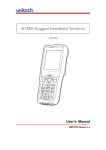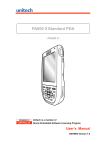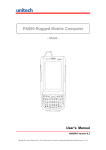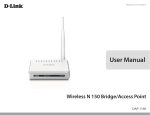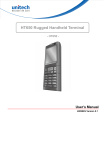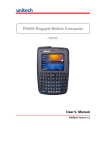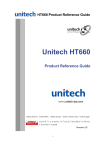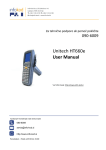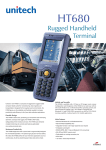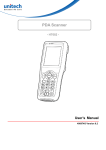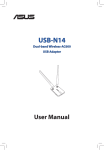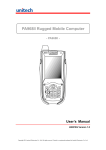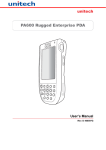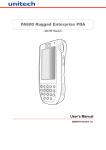Download HT680 - User`s Manual
Transcript
HT680 Rugged Handheld Terminal - HT680 - User’s Manual 400737G Version 1.1 Preface About This Manual This manual explains how to install, operate and maintain the HT680 Rugged Enterprise Terminal. No part of this publication may be reproduced or used in any form, or by any electrical or mechanical means, without permission in writing from the manufacturer. This includes electronic or mechanical means, such as photocopying, recording, or information storage and retrieval systems. The material in this manual is subject to change without notice. © Copyright 2009 Unitech Electronics Co., Ltd. All rights reserved. Unitech global website address: http:\\www.unitech-adc.com Bluetooth is a registered trademark of Bluetooth SIG. Microsoft, Windows and ActiveSync are either registered trademarks or trademarks of Microsoft Corporation. Other product names mentioned in this manual may be trademarks or Registered trademarks of their respective companies and are hereby acknowledged. Unitech is a member of Oracle Embedded Software Licensing Program. i Regulatory Compliance Statements FCC Warning Statement This equipment has been tested and found to comply with the limits for a Class B digital device, pursuant to Part 15 of the FCC rules. These limits are designed to provide reasonable protection against harmful interference in a residential installation. This equipment generates, uses and can radiate radio frequency energy and, if not installed and used in accordance with the instructions, may cause harmful interference to radio communications. However, there is no guarantee that interference will not occur in a particular installation. If this equipment does cause harmful interference to radio or television reception, which can be determined by turning the equipment off and on, the user is encouraged to try to correct the interference by one or more of the following measures: –Reorient or relocate the receiving antenna. –Increase the separation between the equipment and receiver. –Connect the equipment into an outlet on a circuit different from that to which the receiver is connected. –Consult the dealer or an experienced radio/TV technician for help. 1. 2. 3. This Transmitter must not be co-located or operating in conjunction with any other antenna or transmitter. This equipment complies with FCC RF radiation exposure limits set forth for an uncontrolled environment. To maintain compliance with FCC RF exposure compliance requirements, avoid direct contact to the transmitting antenna during transmitting. Any changes or modifications (including the antennas) made to this device that are not expressly approved by the manufacturer may void the user’s authority to operate the equipment. FCC Label Statement This device complies with part 15 of the FCC rules. Operation is subject to the following two conditions: 1. This device may not cause harmful interference, and 2. This device must accept any interference received, including interference that may cause undesired operation. ii Canadian Compliance Statement This Class B Digital apparatus meets all requirements of the Canadian Interference-Causing Equipment Regulations. Cet appareil numerique de la classe B respecte les exigences du Reglement sur le material broilleur du Canada. European Conformity Statement Declaration of Conformity with Regard to the R&TTE 1999/5/EC and EMC 89/336/ EEC directives. RoHS Statement This device conforms to RoHS (Reduction Of Hazardous Substances) European Union regulations that set maximum concentration limits on hazardous materials used in electrical and electronic equipment. Taiwan NCC Warning Statement 交通部電信總局低功率電波輻射性電機管理辦法 (930322) 根據交通部低功率管理辦法規定: 第十二條 經型式認證合格之低功率射頻電機,非經許可,公司、商號或使用者 均不得擅自變更頻率、加大功率或變更原設計之特性及功能。 第十四條 低功率射頻電機之使用不得影響飛航安全及幹擾合法通信;經發現有 幹擾現象時,應立即停用,並改善至無幹擾時方得繼續使用。前項合 法通信,指依電信法規定作業之無線電通信。 低功率射頻電機須忍受合法通信或工業、科學及醫療用電波輻射性電 機設備之幹擾。 iii Laser Information The Unitech HT680 series is certified in the U.S. to conform to the requirements of DHHS/CDRH 21CFR Subchapter J and to the requirements of IEC 825-1. Class II and Class 2 products are not considered to be hazardous. The HT680 series contains internally a Visible Laser Diode (VLD) whose emissions do not exceed the maximum limits as set forth in the above regulations. The scanner is designed so that there is no human access to harmful laser light during normal operation, user maintenance or during prescribed service operations. The laser safety warning label required by the DHHS/IEC for the HT680 series' optional laser scanner module is located on the memory compartment cover, on the back of the unit. CAUTION! Use of controls or adjustments or performance of procedures other than those specified herein may result in hazardous laser light. Use of optical instruments with the scanner will increase eye hazard. Optical instruments include binoculars, microscopes, and magnifying glasses. This does not include eyeglasses worn by the user. Battery Notices The HT680 is equipped with a Lithium-Ion battery pack and backup battery. Both batteries will discharge after an extended period of not being used. If both batteries are discharged, you must recharge the unit for 16 hours in order to fully charge both the main battery and backup battery. You can recharge the HT680 by the following methods: 1. Plug the USB charging cable into the HT680 and plug the 5V/3A AC-DC adapter into the power jack of the USB charging cable. 2. Place the HT680 into the docking station and plug the 5V/3A AC-DC adapter into the power jack of the docking station. iv If the main battery is removed, the backup battery ensures the data on SDRAM is safe for up to 6 hours. To prevent data loss, do not leave the HT680 uncharged with the main battery removed for an extended period. See First Time to Charge the Main Battery & Backup Battery on page 9 for more details. Note: Unitech advises rechargeable batteries be replaced every year or after 500 charge/discharge cycles to guarantee optimal performance. It is normal for the battery to balloon or expand after one year or the maximum of 500 cycles. Although it does not cause harm, the battery cannot be used again and must be disposed of according to the location's safe battery disposal procedures. If the performance decrease is greater than 20% in a Lithium-Ion battery, the battery is at the end of its life cycle. Do not continue to use, and ensure the battery is disposed of properly. The length of time that the battery power lasts depends on the battery type and how the device is used. Conserve the battery life through the following: Avoid frequent full discharges because this places additional strain on the battery. Several partial discharges with frequent recharges are better than a deep one. Recharging a partially charged lithium-Ion battery does not cause harm because there is no memory. Keep the lithium-Ion battery cool. For prolonged storage, keep the battery at a 40% charge level. Do not leave the Lithium-Ion battery discharged and unused for an extended period because the battery will wear out and the battery’s life will be cut in half. Battery charge notice It is important to consider the environment’s temperature whenever the Lithium-Ion battery pack is charged. Charging is most efficient at normal room temperature or in a slightly cooler environment. It is essential that batteries are charged within the stated range of 10°C to 45°C. Charging batteries outside of the specified range could damage the batteries and shorten their charging life cycle. CAUTION! Do not charge batteries at a temperature lower than 0°C, which will make the batteries unstable and unsafe. Please use a battery temperature-detecting device as a charger to ensure a safe charging temperature range. To protect the battery from inflating, the battery includes thermal protection and will not charge when v the temperature of the battery is over 50 degrees Celsius. Storage and safety notice Although charged Lithium-Ion batteries may be left unused for several months, their capacity may be depleted due to build up of internal resistance. If this happens they will require recharging prior to use. Lithium-Ion batteries may be stored at temperatures between -20°C to 60°C, however they may deplete more rapidly at the higher temperature ranges. It is recommended to store batteries within normal room temperature ranges. Warranty The following items covered under Unitech Limited Warranty are free from defects during normal use: HT680 – 1-year limited warranty. Lithium-Ion battery – 6-month limited warranty. Warranty becomes void if equipment is modified, improperly installed or used, damaged by accident or neglect or if any parts are improperly installed or replaced by the user. Use only the adapter supplied. Using the wrong adapter may damage the unit and will void the warranty. vi Table of Contents Preface About This Manual .......................................................................................... i Regulatory Compliance Statements ..........................................................ii FCC Warning Statement.....................................................................ii FCC Label Statement .........................................................................ii Canadian Compliance Statement ...................................................... iii European Conformity Statement ....................................................... iii RoHS Statement................................................................................ iii Taiwan NCC Warning Statement ....................................................... iii Laser Information ......................................................................................iv Battery Notices..........................................................................................iv Battery charge notice..........................................................................v Storage and safety notice ..................................................................vi Warranty ...................................................................................................vi Table of Contents ......................................................................................... vii Chapter 1 Getting Started ............................................................................................... 1 Introducing the HT680 .............................................................................. 1 Notice........................................................................................................ 1 Warranty ............................................................................................ 2 Regulatory ......................................................................................... 2 HT680 Model Specification ....................................................................... 3 HT680 Accessories ................................................................................... 4 Communication and Charging Cradle................................................ 4 Communication and Charging Cable Kits.......................................... 4 Universal Adaptor .............................................................................. 4 Holster ............................................................................................... 4 Hand Strap & Stylus .......................................................................... 4 Li-Ion Battery Pack ............................................................................ 4 HT680 Product Introduction & Accessory Kit ............................................ 5 HT680 Front View.............................................................................. 6 HT680 Rear View .............................................................................. 7 HT680 First Steps................................ Error! Bookmark not defined.8 vii Install the Battery Pack ...................................................................... 8 Switch On Backup Battery ................................................................. 9 Supply Power to the HT680............................................................... 9 First Time to Charge the Main Battery & Backup Battery .................. 9 Protective Screen Film..................................................................... 10 First Time Use of the HT680............................................................ 10 Setting the Time Zone First...............................................................11 Setting Date/Time ............................................................................ 12 Chapter 2 Using the Keypad and Scanner .................................................................. 13 Keypad.................................................................................................... 13 HT680 HotKey ................................................................................. 14 Software Keyboard (Windows CE Keyboard) ......................................... 14 Opening the Windows CE Keyboard ............................................... 14 Other Character Support from WinCE Keyboard............................. 15 Bar Code Scanner .................................................................................. 15 Chapter 3 Power system ............................................................................................... 17 Charging the Lithium-Ion Battery Pack ................................................... 17 Charging the Main and Backup Battery for the First Time ............... 17 Environment Consideration for Charging......................................... 18 Power Status Indication ................................................................... 18 “Backup Battery Low” Icon............................................................... 18 Charging the Lithium-Ion Battery Pack ................................................... 18 Storage and Safety Precautions ............................................................. 19 Backlight Setting ..................................................................................... 20 Warm Boot / Cold Boot ........................................................................... 20 Warm Boot ....................................................................................... 20 Warm Boot via Software .................................................................. 21 Warm Boot via Hardware................................................................. 21 Cold Boot ......................................................................................... 21 Cold Boot via Software .................................................................... 22 viii Chapter 4 Data Communication ................................................................................... 23 Introduction ............................................................................................. 23 Connecting.............................................................................................. 23 Serial or USB Cable......................................................................... 23 Docking Station................................................................................ 24 RF Communication .......................................................................... 24 Using ActiveSync ............................................................................. 24 Installation............................................................................................... 25 Using the Mobile Devices Window.......................................................... 27 Changing Communications Settings....................................................... 28 Wireless Communication ................................................................. 28 Bluetooth Setup ............................................................................... 29 Bluetooth ActiveSync ....................................................................... 29 Chapter 5 Useful Utilities .............................................................................................. 31 Introduction ............................................................................................. 31 Scanner Setting ............................................................................... 31 Scan2Key ........................................................................................ 33 Registry Backup/Restore ................................................................. 34 UniPing ............................................................................................ 34 Chapter 6 Device Setting .............................................................................................. 35 Introduction ............................................................................................. 35 Info................................................................................................... 36 Funckey ........................................................................................... 36 IO ..................................................................................................... 37 Server .............................................................................................. 37 Virtual Key ....................................................................................... 39 Screen ............................................................................................. 40 Ping.................................................................................................. 40 CPU ................................................................................................. 41 Backup............................................................................................. 41 Battery ............................................................................................. 41 Appendix Worldwide Support ...................................................................................... 43 ix x Chapter 1 Getting Started Introducing the HT680 Notice 1. 2. This unit is equipped with a battery pack and backup battery. It is possible that the Unitech HT680 may not be powered on due to battery discharge as a result of storage. In the above situation for first-time use, plug the HT680 to the charging cable or charging cradle (with 5V/2A AC-DC adapter), and charge the unused unit for over 16 hours in order to fully charge both batteries. Under normal conditions, the backup battery will be charged from external 1 power or the main battery (if the main battery still has enough power to turn on). If it is charged for the first time, the backup battery will be fully charged if the main battery is fully charged. Warranty Unitech's Limited Warranty provides four different warranty periods for different parts and accessories: Terminal is covered by one-year limit warranty. Docking Station is covered by one-year limit warranty. Cable is covered by one-year limit warranty. Battery is covered by three-month warranty. Regulatory Compliance with VCCI, CE, FCC, BSMI, UL, CCC 2 HT680 Model Specification Rugged/Environment Keypads Physical Drop 1.5M IP Rating IP54 Operation Temp. -10°C to 50°C Storage Temp. -20°C to 70°C (W/O Battery) Humidity 5%~95% non-condensing ESD Contact ± 8KV, Air ± 12KV Full Alphanumeric 12 keys Weight (g) 280g ± 10g (W/O Battery) Dimension (L x W x H mm) 169 x 55 x 30 Main Battery Type Power supply & Management Battery Recharging Time 3.7V / 2200mAH Li-ion, 8.14WH Under 4 hrs. BT Up to 12 hours Battery Life WLAN 8 hours GPRS 6 hours Backup Battery Type 70mAH Li-polymer 2.7” Color TFT LCD with Touch v Display Panel Display pixels Docking Station Bar code Scanner Reader System Architecture Speaker 240 x 320 pixel USB/Ethernet, Four-Bay Multi. Charger 1D Laser & 2D Imager CPU Processor PXA270 - 520MHz Operating System WinCE 5.0 Pro. Flash ROM 512MB SDRAM 128MB v Communication Interface USB Client / USB Host Expansion Memory Slot Radio Options miniSD Slot v 802.11b/g/ GPRS / GPRS EDGE v Bluetooth v Remark: V= Contain ; X= Not Contain 3 HT680 Accessories Each of the following items are sold separately to enhance your HT680 terminal’s capabilities. Communication and Charging Cradle The USB cradle is for data transmission and charging purposes. The modem cradle is for data transmission via phone lines and charging purposes. Communication and Charging Cable Kits The included USB cable or an optional serial cable connects the HT680 terminal directly to a peripheral device for communication and acts as a power source for charging. Universal Adaptor This power supplier adaptor plugs the terminal directly into a switch to power the terminal and charge the battery pack. This accessory converts the 120~240 Volts for different countries use. Holster The holster holds the terminal for mobile use. Hand Strap & Stylus The hand strap is convenient for carrying your HT680 and also includes a stylus attachment. Li-Ion Battery Pack The 3.7v, 1950mAh Li-Ion rechargeable battery pack provides the main power supply for HT680 terminal. 4 HT680 Product Introduction & Accessory Kit HT680 Terminal Manual CD Communication Cable Battery Adaptor Plugs Communication Cradle 5 HT680 Front View LED Indicator Touch Screen Display Trigger Function Alpha I/O Port Power 6 HT680 Rear View Bar Code Scanner miniSD Slot Stylus Speaker Battery Cover 7 HT680 First Steps Before using the HT680 for the first time, please ensure the battery is fully charged. There are three ways to charge your HT680: Docking station USB/charging cable Rechargeable Lithium-Ion battery pack NOTE: Data loss may occur if the HT680's backup battery is not adequately charged. Before charging the main battery, make sure the backup battery switch is ON. Install the Battery Pack 1. Remove the battery cover. 2. Move the backup battery switch to the ON position (see the description below). Insert the battery pack so that the contacts on the battery pack line up with the contacts in the battery compartment. Fully secure the battery. 3. 8 4. Replace the battery cover. Switch On Backup Battery Locate the backup battery switch inside the battery compartment on the left-hand side. Please ensure that it is in the “ON” position before charging the main battery. Supply Power to the HT680 Connect the USB/Charging Cable to the HT680 and connect the AC adapter to the cable’s power jack and an electrical outlet. Or place the HT680 into the Docking Station (first connect the power supply to the Docking Station). First Time Charging the Main & Backup Battery Unitech recommends charging the battery at least up to 16 hours for the first time to use. While it normally only takes about 4 hours to charge the battery after it's been drained, when charging the battery for the first time please allow at least 16 hours. While charging the main battery the backup battery should also be charged. It is imperative the backup battery has been switched “ON”. 9 CAUTION: There is a high risk of data loss from RAM if the backup battery is not fully charged. This can happen if the main battery has been drained and the unit is not connected to the AC adaptor. For this reason, it is crucial that the backup battery is switched on before charging the main battery for the first time. Protective Screen Film To protect the screen during shipping, the HT680’s screen is covered with a protective plastic film. You may remove it if required. The screen will be more susceptible to scratching without the film, but can be read and used easier. First Time Using the HT680 Pressing the Power ON/OFF Key The Unitech HT680 welcome screen appears. The Windows CE screen will appear shortly thereafter. Align the Screen When prompted, use the stylus to select the targets as they appear in order to align the touch screen. When you complete the procedure, press any key or press anywhere on the touch screen to start up the WinCE system. Adjusting Screen Brightness To adjust the original default setting of the screen brightness, the backlight setting will be required. Please refer to page 20 for the new setting procedure. 10 Setting Time Zone/ Date Before using the HT680 please take a few minutes to set the time and date so that data can be properly time-stamped. Setting the Time Zone Follow the steps below to set up your time zone. 1. Select the location arrow to see a list of cities. 2. Choose your location (or nearest listed one). 3. Select the Daylight Savings Time check box, if necessary. 4. Select the Apply button. If you would like the terminal to automatically adjust the clock for daylight saving, please select the appropriate box. 11 Setting Date/Time Select the Left or Right Arrows to scroll to the year and month you desire. To set up the time, select the Hr/Min/Sec AM/PM to input the Hr/Min/Sec 12 Chapter 2 Using the Keypad and Scanner Keypad Data can be entered into the HT680 via the keypad, which includes: alpha, function, escape, enter, scanner trigger, cursor, and on/off keys. 0~9, Scan Key Enter Key Escape Key Cursor Key Power ON/OFF Key Function Key [ENT] Alpha Key The Enter key confirms data entry. [FUNC] The Function key is used in conjunction with specific number keys to operate as HotKeys (see next page). [ESC] The escape key returns the user to a previous page. [Cursor] The cursor key moves the cursor around the screen. [Alpha] The Alpha key toggles Alpha mode on and off and Caps mode on and off. One press of the Alpha key causes the HT680's keys to input alpha characters, indicated by a blue LED light. A second press causes the input of upper-case characters, indicated now by a green LED. A third press returns the HT680 to numerical input. 13 HT680 HotKey The HT680 provides HotKeys for frequently used functions. Press the Function key and the appropriate numeric key for the following functions listed below: Func 6 = Task Manager Func 7 = Scanner Setting Func 8 = Power Properties Func 9 = System Info HotKeys can be modified to suit the user's preferences. To modify HotKeys, please follow the path below: Path: My computer/Windows/RegFuncKey.exe Software Keyboard (Windows CE Keyboard) Besides its hardware keypad, the HT680 provides a touch screen keyboard as an alternative method of character input. This software keyboard replicates the layout of a standard PC keyboard. Opening the Windows CE Keyboard The Windows CE keyboard can be opened by selectping the “keyboard” icon on the task bar. (Refer to picture). 14 Other Character Support from WinCE Keyboard In addition to standard keyboard input, the HT680 supports special European character and symbol input. To enter these characters, select the [áü] key on the touch screen keyboard to display the available characters. Bar Code Scanner The HT680 has an integrated 1D laser and 2D imager bar code scanner (depending on model number) capable of reading all major bar code labels. 15 16 Chapter 3 Power system Charging the Lithium-Ion Battery Pack The HT680's batteries can be charged via the USB or serial communication cable, or via the optional docking station - both using the included AC adaptor. Please charge the battery for at least 4 hours per session to ensure a full charge. Please note that the first time charge should be for at least 16 hours (see the description below). Charging the Batteries for the First Time When first charging the HT680, please allow at least 16 hours to fully charge both the main and backup batteries. When the HT680 arrives from the factory the backup battery switch is in the OFF position in order to protect the backup battery. Before first charging the HT680, make sure the backup battery switch is moved to the ON position. The backup battery switch can be found inside the main battery compartment. Data loss can occur if the backup battery is not adequately charged - therefore it is imperative to ensure that the backup battery switch is in the ON position before charging for the first time. A properly charged backup battery can store data for up to 72 hours without power from the main battery. This is not recommended. Please make sure an adequately charged main battery or AC power is presented and try not to rely on the backup battery for anything other than unusual or emergency situations. To prevent data loss due to backup battery failure, please minimize the amount of time that the backup battery has to operate without the main battery pack installed or while disconnected from AC power. 17 Environment Consideration for Charging It is important to consider the environment’s temperature whenever you are charging the Lithium-Ion battery pack. The process is most efficient at normal room temperature or slightly cooler. It is essential that you charge batteries within the stated range of -5°C to 50°C. Charging batteries outside of the specified range could damage the batteries and shorten their charging life cycle. Power Status Indication When the "Main Batteries Very Low" icon appears, charging the main battery pack as soon as possible is highly recommended in order to avoid system shutdown. “Backup Battery Low” Icon When the "Backup Battery Low" icon appears, it indicates that the backup battery is low and needs to be charged. Charging the Lithium-Ion Battery Pack Automatic shutdown of the HT680 The HT680 will enter idle mode when there is no task, or all tasks are waiting for input. In the default setting, the HT680 will automatically turn itself off if it remains idle for 3 minutes and when there is no external charging power applied. Pressing the power button will return the HT680 to the same point at the time of automatic shutdown. 18 Conserving the battery: Suggestion 1: Turn off wireless mode if you are not using it. This will conserve battery power. Suggestion 2: Disable the I/O card if Internet access is not required. Storage and Safety Precautions Batteries should be stored in an open environment and placed where there is no risk of accidental shorting or other damage. Although charged Li-Ion batteries may be left unused for several months, their capacity may be reduced due to back up and internal resistance. If this happens they will require recharging prior to use. Li-Ion batteries may be stored at temperatures between -4°F and 158°F (-20°C to 70°C). 19 Backlight Setting The backlight for color display is user-defined. There are two tabs – one for Battery Power and the other for External Power. Field Description Dim Backlight Select how many minutes you want to elapse before the backlight dims. Turn Off Backlight Select how many minutes you want to elapse before the backlight automatically turns off. Turn on Backlight Select this option if you want the backlight to turn on when the button is pressed or the touch screen is selected. Warm Boot / Cold Boot Warm Boot A Warm Boot will reset the HT680 without losing any saved data. Perform a warm boot when: The terminal fails to respond. After installing certain software applications. After making changes to certain system settings such as network cards. WARNING - Performing a Warm Boot will result in the loss of all unsaved data! 20 Warm Boot via Software To perform a Warm Boot via software, locate the file Windows/Boot.exe. Select “Warm Boot”. The system will be warm started. Warm Boot via Hardware warm-boot Use a blunt pin (like an unfolded paper clip) to stab the warm-boot pinhole located on the front of the HT680, above the keypad. pinhole Cold Boot A Cold Boot is used to reset the operating system, restore the terminal back to factory default, and reset the terminal after a bootloader, keyboard, or kernel upgrade. You may stab the cold-boot pinhole to cold boot the HT680. cold-boot pinhole WARNING - Performing a Cold Boot will return the HT680 to its original factory settings! 21 Cold Boot via Software To perform a Cold Boot via software, locate the file Windows/Boot.exe. Select “Cold Boot”. The system will be re-started and reset back to factory default. You will need to recalibrate the screen and reset the date and time. Cold Boot via Hardware 1. 2. 3. 4. 5. 6. 22 Remove the Main Battery. Switch OFF the Backup Battery. Switch the Backup Battery back ON. Insert the Main Battery. The terminal will be cold started and reset back to factory default. Recalibrate the screen and reset the date and time. Chapter 4 Data Communication Introduction The Unitech HT680 allows users to link to a host computer via RS-232 / USB, Bluetooth, or Wireless connection for data communication. This chapter provides an overview of the communication of the HT680. The following subchapters cover these topics: “Series, USB or Modem” communication via cable or docking station. “RF Communication” for details about wireless communication between the HT680 and host computers. “Microsoft ActiveSync” for details about serial communication through a USB port. Connecting Serial or USB Cable 23 Docking Station USB Cradle For data transmission, plug one end of your HT680's USB communication cable into your PC's USB Port and the other end into the docking station's USB port. To simultaneously charge the HT680, plug the AC power adaptor into the power receptacle on the Docking Station. RF Communication Windows CE can support TCP/IP protocol and the user can link to the Internet through the settings under “Network and Dial-up Connections”. In the Network and Dial-up Connections, go to PRISM1 to set up the IP to connect to the internet. Using ActiveSync Using Microsoft ActiveSync, you can synchronize and transfer information between your desktop computer and terminal. The most current version of ActiveSync can be downloaded from www.microsoft.com. Additional Capabilities With ActiveSync, you can also: Back up and restore your device data. Copy (rather than synchronize) files between your device and desktop computer. Control when synchronization occurs by selecting a synchronization mode. For example, you can synchronize continually while connected to your desktop computer or only when you choose the synchronize command. Select which information types are synchronized and control how much data is synchronized. For example, you can choose how many weeks of past appointments you want synchronized. 24 Before beginning installation, carefully read the following: Because you will be restarting your computer during installation, save your work and quit all programs before you begin. To set up your communication settings, the HT680 serial cable is required to connect the HT680 to your host computer. If you run the Windows NT® operating system with a service pack, you will be informed during setup that you may need to reinstall the service pack. Try connecting first, and if unsuccessful, reinstall the latest service pack. Requirements To synchronize, ActiveSync version 3.7 or higher must be installed on both your desktop computer and the HT680 terminal. The HT680 terminal is installed with ActiveSync before being shipped. Therefore, you must only install ActiveSync 3.7 on your desktop computer. To install ActiveSync on your desktop computer, please link to the Microsoft website to get the free download driver. Installation Follow the installation procedure below to install Microsoft ActiveSync, connect your HT680 to your desktop computer, and establish a partnership for synchronization, if required. Download the executable program “msasync. exe” from the Microsoft web site at: http://www.microsoft.com/mobile/pocketpc/ downloads/activesync35.asp. Execute this program. Select the folder into which Microsoft ActiveSync will be installed. If you choose not to download into the displayed default folder, click the Change button. 25 After you’ve selected the folder, click Next to set up Microsoft ActiveSync. After you’ve installed Microsoft ActiveSync and restarted your computer, you’ll see the screen pictured: Using the USB, plug the HT680 into a communication port on your desktop computer. Turn the HT680 on and click the Next button. Microsoft ActiveSync should recognize your HT680 and configure your communication port. If a message appears indicating that it is unable to detect a connection, click the Cancel button and manually configure the communication settings. When the HT680 is initially connected to a PC, the following screen appears prompting you to set up a “Partnership”. Setting up a Partnership is required if your HT680 is to be synchronized with other computers and/or terminals. Otherwise, you may select No. Click synchronization settings. Currently the HT680 can support “Synchronized Files”. Different HT680s cannot share the same Device Name if more than one terminal is to be connected to the same PC via a “Partnership”. The default Device Name assigned to the HT680 is “WinCE”. It is important to specify a different name for each When ActiveSync displays the following screen, assign each terminal its own unique name. 26 Click the Next button and follow the instructions to set up a partnership between the HT680 and your desktop computer. This partnership allows you to synchronize information between the two computers. When the configuration process is complete, you will see the following screen. Synchronization will be initialized and will take place depending upon your chosen settings to synchronize periodically or upon connection. Note: Your desktop computer can create a partnership with multiple HT680 terminals. Also, The HT680 can create a partnership with up to two desktop computers. Using the Mobile Devices Window Start Microsoft ActiveSync by clicking the Microsoft ActiveSync shortcut on your desktop and then clicking the “Explore” icon. In the displayed window, you can select for your HT680 to use Microsoft ActiveSync features such as changing synchronization options, as described in the “Synchronization” section. 27 Open the Explorer window by double clicking your device icon in the Mobile Devices window. Use this window, which is the root window to the HT680, to copy and move files between the HT680 and your desktop computer, as described in the “Synchronization” section. Changing Communications Settings If Microsoft ActiveSync fails to detect the HT680 during installation, you must set up communications manually instead. Make sure the following conditions are met: Verify that the correct communications port is selected for your desktop computer and that it is free. Microsoft ActiveSync uses the specified communication ports to connect to the HT680. Make sure these resources are available for Microsoft ActiveSync to connect to the HT680. Other programs cannot use them while the HT680 and your desktop computer are connected. Set your baud rate on the HT680 - the desktop computer will match it. To check the communications settings, open the Mobile Devices folder, and click File / Connection Settings. The connection on the HT680 is set to USB connection by default. To adjust the connection, select Start, Settings, Control Panel, select the Communication icon, select the PC Connection tab, and then select the Change Connection button. For more information see Microsoft ActiveSync Help. Wireless Communication Your HT680 is equipped with built-in Bluetooth for wireless communication. 28 Bluetooth Setup Select the BTPowerON program from Wireless Connection on your HT680’s Startup Bar/ Program/ Bluetooth Select Bluetooth Module Power On and select OK. Bluetooth ActiveSync Select BTActiveSync from Communication on the Startup bar. On your PC, select the Bluetooth icon on the task bar. The screen to the right will appear. Select More... 29 Choose Inquiry. The inquiry process might take a few seconds. Then, select the device to synchronize and select OK. Select the Bluetooth icon on the task bar again. Click Sync. The message “Connecting to Bluetooth” will appear on your HT680. A Bluetooth security screen will appear prompting you to enter a PIN code. This PIN code can be any series of letters and numbers, and must be the same code you enter on your HT680 when prompted. When prompted by your HT680, enter the same PIN code that you entered on your PC. Once it is successfully entered, your synchronization is complete. 30 Chapter 5 Useful Utilities Introduction Scanner Setting data, and save the settings. Run this program from \Start\Setting\Control Panel\Scanner Setting.exe and Scanner Control Panel will be displayed. Bar Code Symbologies Char Bar code Enable/ Check / Symbology Disable Digit verification Bookland Transmit Check Char/digit Max/Min Length Leading Digit Others Transmit YES EAN Codabar YES YES YES Transmit Start/Stop bits, CLSI format, *data length Code 11 YES YES * check digits *data length Code 128 YES *data length Code 32 YES Transmit Tailing digit Code 39 YES YES For ASCII, Transmit 31 Char Bar code Enable/ Check / Symbology Disable Digit verification Transmit Check Char/digit Max/Min Length Leading Digit Others Transmit Start/Stop bits, Function Code, Double label decoding,*data length, *double labels separator Code 93 YES Deta Code YES EAN 128 YES YES YES *data length YES YES Transmit Code ID, * Field separator EAN 13 YES YES EAN 8 YES YES * Not suppress first or last digit, *data length Interleaved YES YES YES Fixed Length, * 2 of 5 Not suppress first or last digit, *data length Label Code YES YES IV&V MSI/Plessey YES YES * Check digit double module 10, * data length Interleaved YES YES YES Fixed Length, 2 of 5 Telepen *Data Length YES *Standard Character Set UPC A YES YES YES UPC E YES YES YES Zero Expension,NSC 32 Char Bar code Enable/ Check / Symbology Disable Digit verification Transmit Check Char/digit Max/Min Length Leading Digit Others Transmit UPC/EAN Supplement 2, Group Supplement 5, Insert Space before supplement, most have supplement, *Add-on code try level Note: *Value Adjustable Scanner Control Panel V3.0 Scan2Key The Scan2Key application routes input from the scanner port to the keyboard buffer, with the result that all scanned data is treated as if it was inputted from the keypad. With this router, scanned data can be directly put into generic applications like MS Pocket Word. Scan2Key can be found at: \Start\Setting\Control Panel\Scanner Setting\ To kpd. 33 Registry Backup/Restore The Registry Backup program stores the HT680's registry settings for the user to access. If a cold boot should be required, or the user otherwise wants to return the registry to a previous state, the user can retrieve an earlier setting from Registry Backup. Registry Restore allows the user to restore the HT680s registry to a previously saved version. \Start\Program\Utilities\Registry Backup UniPing This Unitech program enables the user to ping their IP to determine the status of the connection. 34 Chapter 6 Device Setting Introduction The Device Setting is a short cut for you to view device information and change settings, such as Function Key, I/O, Server etc. The following description will guide you through completion of all device-setting items. 1. Click Control Panel in My Device. 2. Double click Device Setting. 35 Info The Info tab shows general information of the terminal such as the OS version, memory space, battery power, product ID and etc. Funckey 1. Select the “FuncKey” tab. Users can change the four hot keys. 2. Select “Func6”. Select “Browse” to select a file. Select “Set”. 3. Press “Func” key and “6” key. Func6 will call the application that the users specified. You can repeat the steps for Func7, Func8, and Func9. By default: Func6 – Task Manager Func7 – Scanner Settings Func8 – Power Properties 4. 36 IO 1. Select “IO” tab. 2. Under status, select “Enable” or “Disable”. 3. When enable, SD/ Wireless card is always accessible; when disabled, SD/Wireless card is not accessible. Server Server Manager is a tool for the user to manager the NTLM (Windows NT LAN Manager) users, FTP users and telnet users. Account Manager NTLM 1. Select “Server” tab. 2. Select “NTLM”. Click “Add” to add a new user. 3. Key in the user name and password. Click OK. 4. To modify a user’s password, select the user and select “Modify”. 5. Enter the new password and confirm password. Select OK. 6. To delete a user, select the user you want to delete, and click “Delete”. 37 FTP 1. Under “FTP” tab, tap “Add” to add FTP user. 2. Select the user and tap “Add”. 3. To delete ftp user, select the user and select “Delete”. You will see the dialog box – “Do you want to delete the user X?” Select “Yes”. Telnet 1. Under “Telnet” tab, select “Add”. Add the telnet user from NTLM. 2. Select the user and click “Add”. 3. To delete telnet user, select the user and click “Delete”. You will see the dialog box – “Do you want to delete the user X?” Click “Yes”. 38 Server Settings Option 1. Click “Option”. For telnet server setting, enable/disable server. 2. For FTP server setting, enable/disable server and define anonymous login. Save Select “Save” to save the server settings. Load Select “Load” to load the saved server settings. Virtual Key This tool allows you to enable/disable the alpha keys on the terminal’s keypad, set auto enter and enter character delay. 1. Select “Virtual Key” tab. 2. Check “Enable Virtual Keys Applet”. Select Set. Select OK. 3. Open MS WordPad and test alpha keys. Press “alpha” key and press numeric key. The characters output as alpha keys. 4. Uncheck “Enable Virtual Keys Applet”. Select Set. Select OK. 5. Press “alpha” key and press numeric key. The characters output as non-alpha keys. 6. In “Virtual keys”, enter the time delay for “Delay To Send Key”. Characters will be output in the speed as defined. 7. In “Virtual keys”, check “Enable Auto Enter”. 8. Define a value for “Auto Enter Timeout”. Select Set. Select OK. 9. In MS WordPad, turn to alpha mode. Press and hold a key. The alpha characters are highlighted in a loop. Release the key. The character, which was focused on will be printed after a period of time, according to the auto enter timeout defined. 39 10. Select “Load” to load the previous setting. Screen 1. Select Rotate Right. Screen rotates to the right. 2. Select Rotate Left. Screen rotates to the left. 3. Select Upside Down. Screen rotates upside down. Ping This tool allows you to ping to other devices in LAN network while your terminal is connected to the network. 1. Select “Ping” tab, on Host field, enter the IP address of the device you want to ping to. 2. Check “Constant Ping” so that your terminal will continuously ping to the remote device. 3. Select “Start”. The terminal will search for the remote computer with the IP address, which you entered. If not found, you will see “Request Time Out”. If the remote computer is found, you will see “Host Responding”. 40 CPU This allows you to select the speed of the CPU according to your requirement of the performance. 1. Select “Most Efficient”: This will speed up the CPU but is consumes a lot of power. 2. Select “Most Power Saving”: This will save the battery power but the efficiency is lower. 3. Select “Dynamic arrange”: This will let the speed changes according to the system status. 4. For every selection, select the “Apply” button to save changes. Backup This tool allows you to save the current registry or reset to factory default. 1. Select “Backup” tab. 2. Select “Save” to save current registry settings. 3. Select “Restore” to reset the registry to factory default. The terminal will be warm started. (Note that the “Restore” button is unavailable if the registry setting was not saved before.) Battery This tool allows you to charge the battery in the Smart Charge mode as soon as the battery life decreases to the level to which you selected. After changing the charge mode, you are required to warm boot the device. Whenever you charge the battery in the Smart Charge mode, turn ON the device. The default charge mode is Normal Charge. 41 42 Appendix Worldwide Support Unitech’s professional support team is available to quickly answer questions and technical-related issues. Should an equipment problem occur, please contact the nearest Unitech regional service representative. For complete contact information please visit the Web sites listed below: Web Site Region Global Operation Center www.unitech-adc.com Unitech Asia Pacific & Middle East www.unitech-utp.com.tw Greater China Division www.unitech-sbd.com Unitech Japan www.unitech-japan.co.jp Unitech America www.ute.com Unitech Latin America www.latin.ute.com Unitech Europe www.unitech-europe.nl 43























































